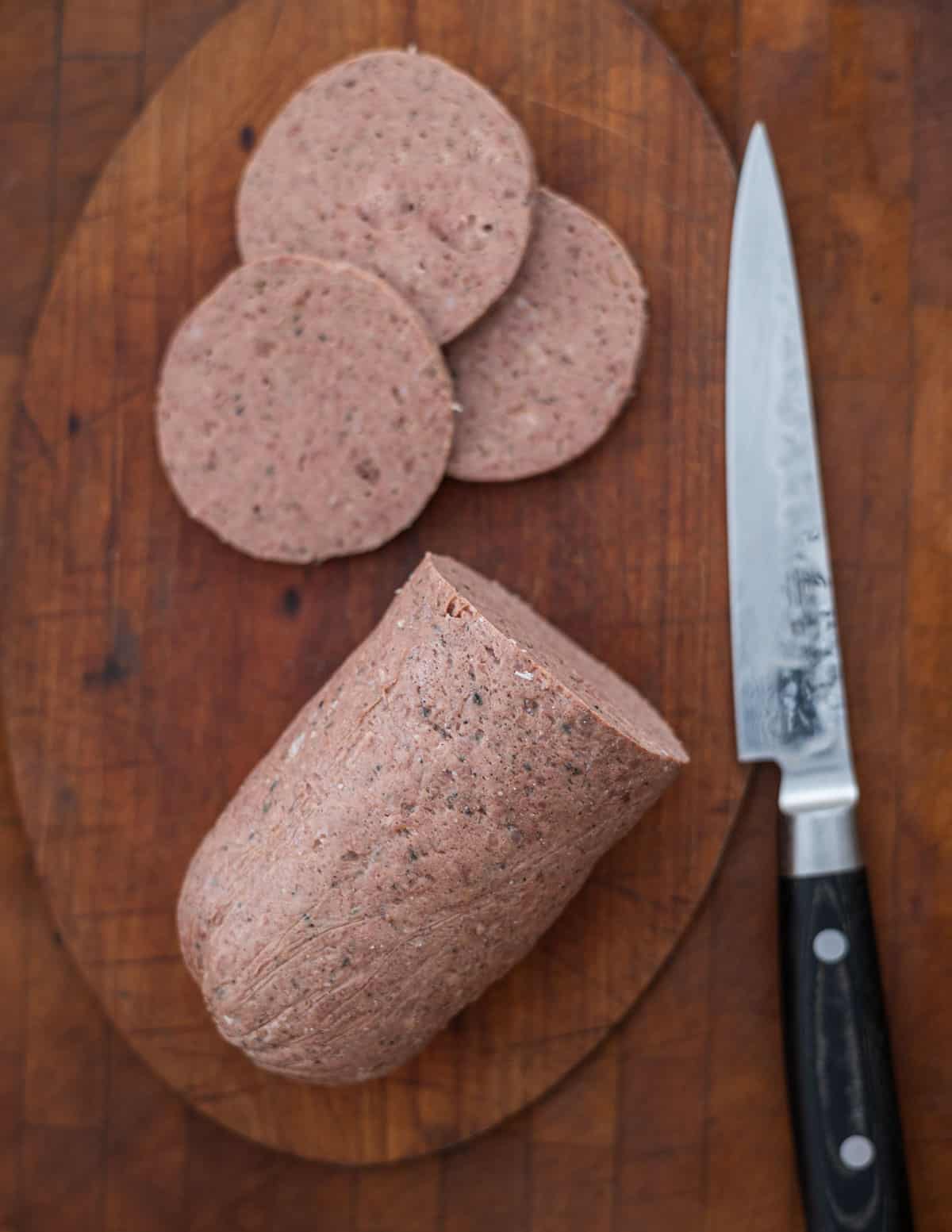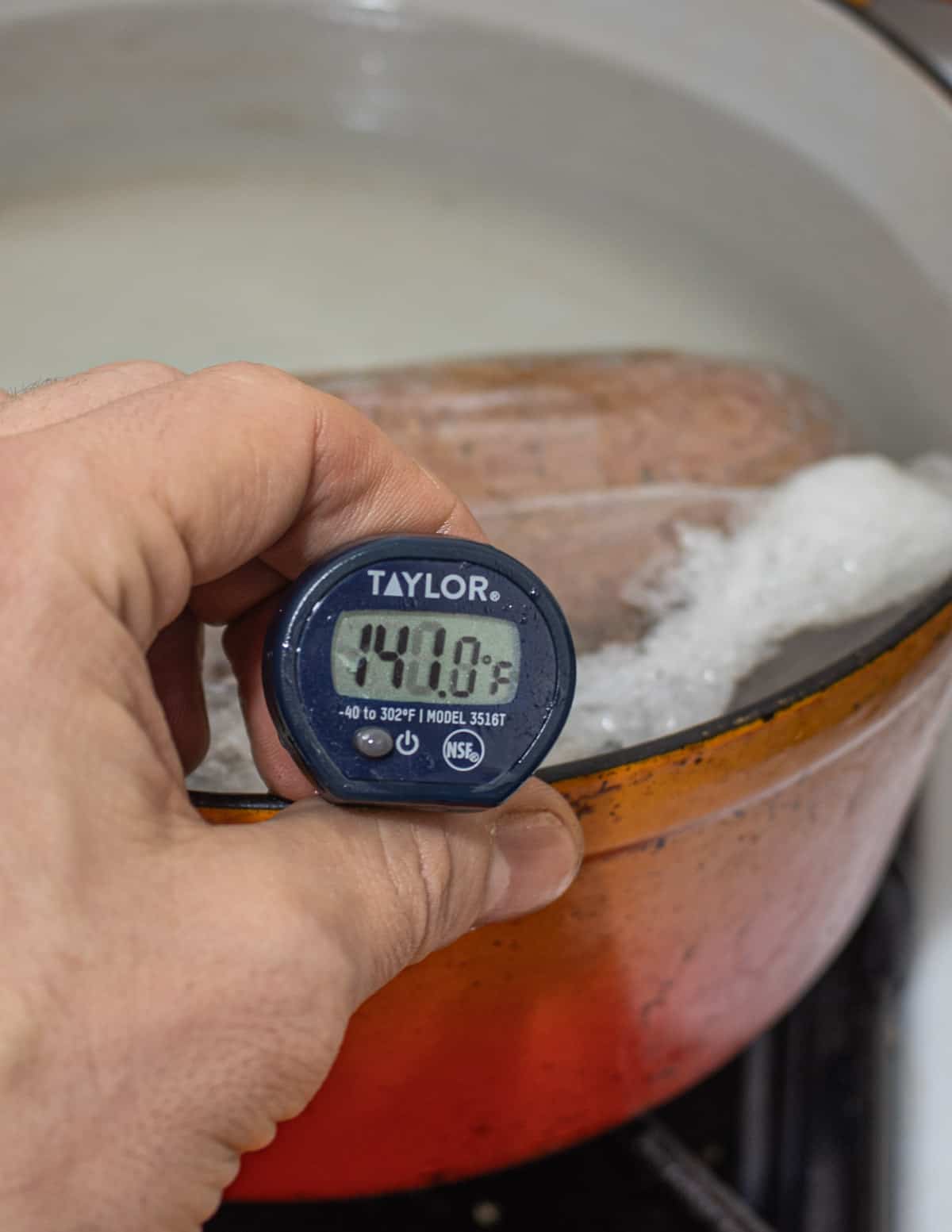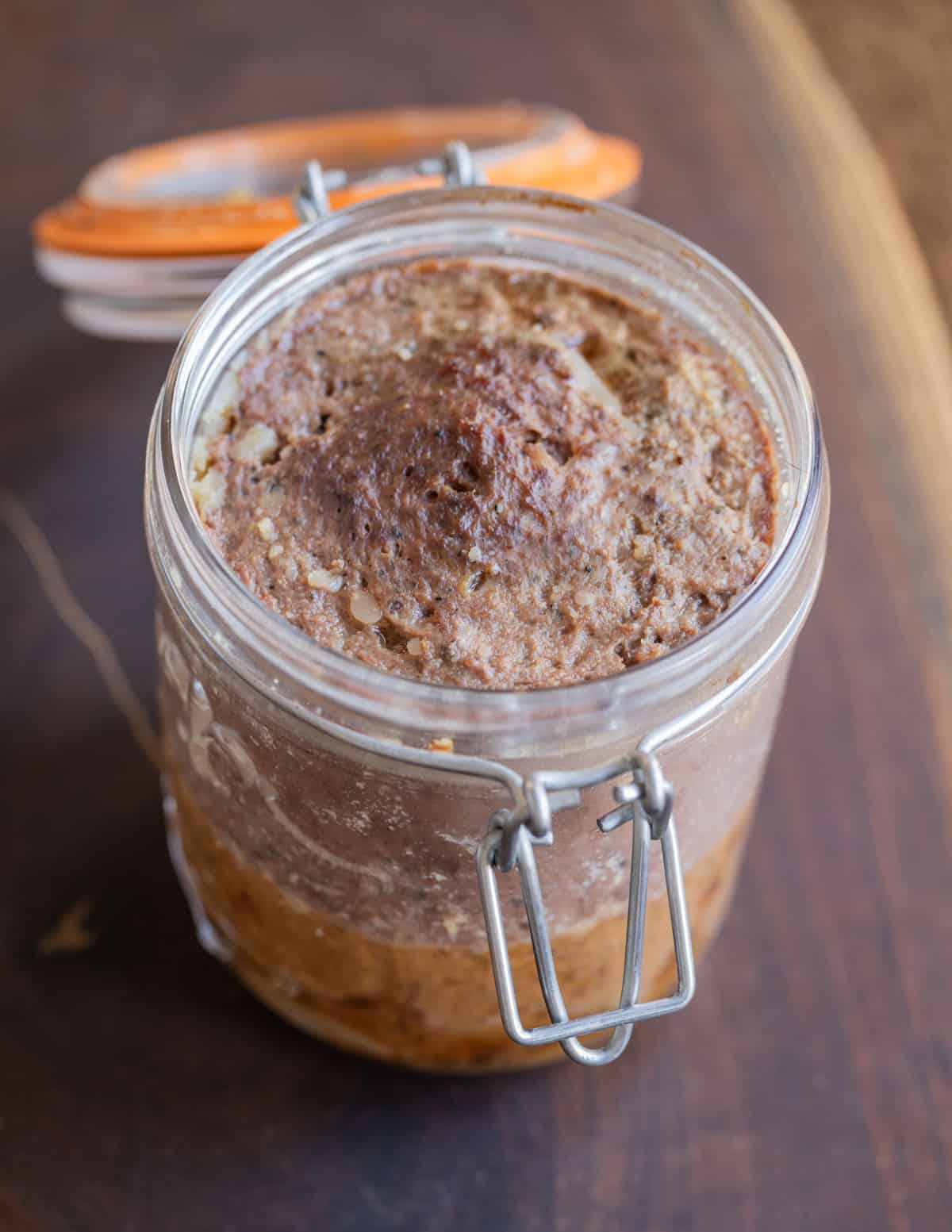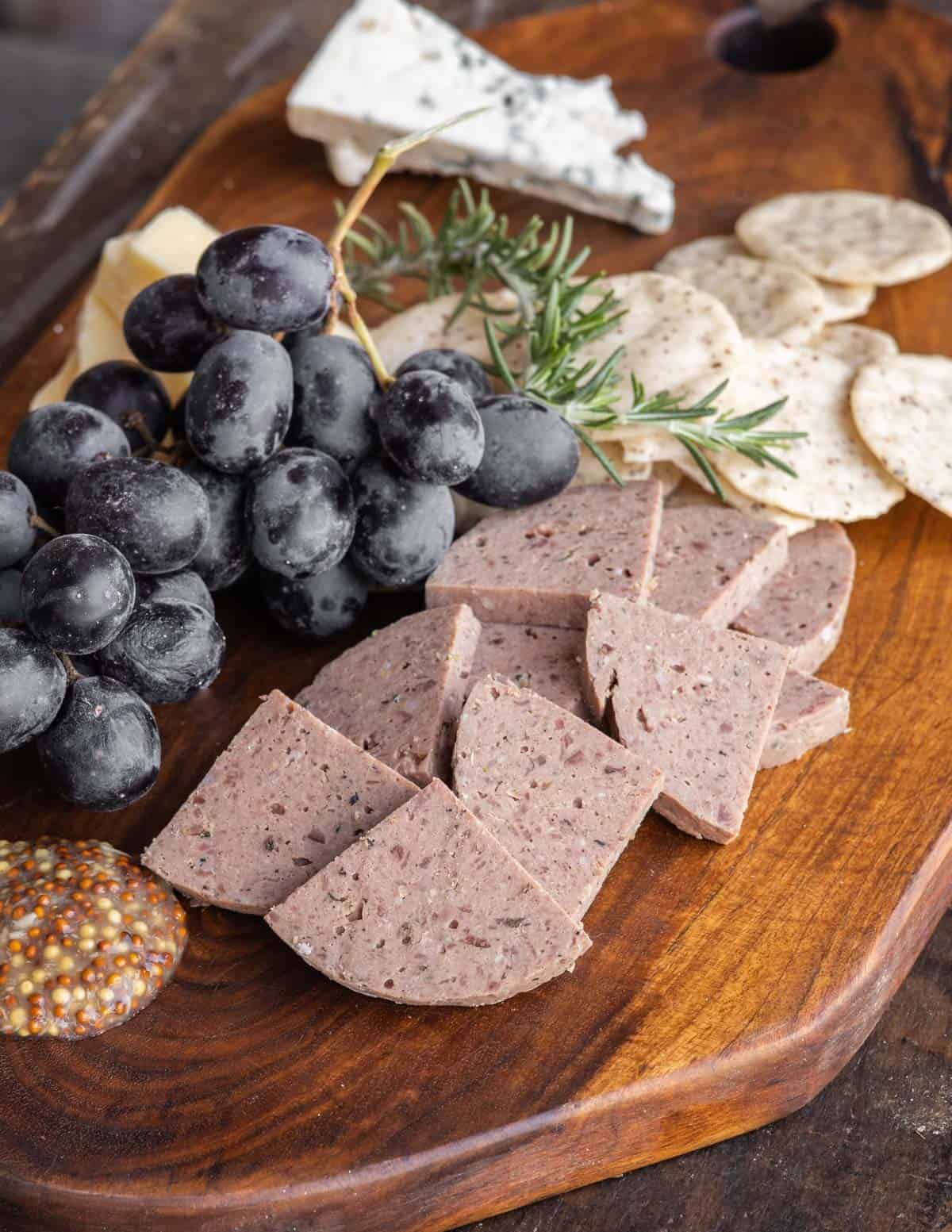Sausage and charcuterie are one of the best ways to use liver and enjoy nose to tail cooking in your kitchen. Here's a great homemade liverwurst or braunschweiger recipe you can make at home. Everyone loves it I've served it to, and plenty of people won't even know there's liver in it.

What is Braunschweiger?
Braunshweiger is a type of German liver sausage, sometimes called liverwurst. There's many regional variations with different seasonings and ingredients. Sometimes it is soft and nearly spreadable, other times it may be more firm like a terrine or meatloaf. Commercial liverwurst is often soft and spreadable.
How to Make Braunschweiger
You'll need a few pieces of equipment. The most important is a meat grinder and a stand mixer. The recipe straightforward, but does take a little time to make.

First the liver is browned in a pan. Next the liver, meat, fat and spices are mixed and ground through the meat grinder a couple times. Once the meat has been ground and mixed, it's formed and cooked to 150 F.

You can use cling film, a mason jar or loaf pan like I do with my chicken or venison terrine.

After the meat is cooked, it's cooled, sliced and eaten. It's the perfect accent to your next charcuterie board.

More Nose to Tail Recipes
Classic Homemade Braunschweiger or Liverwurst
Equipment
- Meat Grinder
- Stand mixer
- cling film
Ingredients
- 18 oz Diced meat such as beef chuck or pork shoulder
- 6 oz Pork fat or kidney suet
- 8 oz Bacon
- 16 oz Beef liver pork liver, venison liver or lamb can also be used
- 1 small onion (4 oz) finely chopped
- 1 oz cooking oil, like grapeseed, separated (2 tablespoons)
- ¼ cup brandy or cognac
- ¼ cup heavy cream
Braunshweiger Spices
- 5 g 1 teaspoon pink curing salt Sodium nitrite (ask your butcher for this)
- 15 g 1 Tablespoon kosher salt
- 2 tablespoons dry white wine cold
- ½ a nutmeg grated
- 8 g black or white pepper, freshly ground (1 tablespoon)
- 1 tablespoon dried marjoram (1 g)
- 2 tablespoons mustard powder such as Colemans
- 2 teaspoons grated ginger
- 1 teaspoon dried bay leaves finely ground in a spice grinder
- 6 tablespoons milk powder* see note
Instructions
- Pat the liver dry. Season the liver with salt and pepper. Heat half the oil in a skilet on high heat and brown the liver well on all sides. Remove and pour off any oil, then add the onion and the additional oil to the pan and cook until softened, about 5 minutes.
- Add the brandy and cook until the pan is nearly dry. Scrape up the browned bits. Add the heavy cream and reduce by half. Scrape the onion mixture into a small bowl or and chill.
- Cut the bacon into 1 inch pieces. Dice the cooked liver, meat and fat, mix with the bacon, onions, and the seasonings except the wine and milk powder. Grind the mixture through the small die of a meat grinder.
- Chill your meat mixture in the freezer for 15 minutes then pass iit through the small die again. Repeat the process once more so that you've ground the meat 3 times.
- As some readers have noted, 3 passes through the grinder is optimal and makes the finest texture, but 2 can give you a similar product.
- Transfer the mixture to a stand mixer and add the wine and ⅓ of the milk powder. Begin to mix on low speed. Keep a towel wrapped around the bowl to prevent milk powder from getting everywhere. Gradually add the rest of the milk powder.
- Clean meat from the paddle attachment if needed to ensure even seasoning.
- Cook a small piece of the liverwurst to test the seasoning. Adjust until it tastes good to you. You may need to adjust the seasoning a few times. Refrigerate the sausage overnight for the most even, well flavored result.
Forming and Cooking
- Pack the sausage into a loaf pan or another mold. For a circular shape you can wrap it in cheesecloth and poach in salted chicken stock or use an oven-safe jar.
- Cover the pan with a lid, or use a layer of parchment and foil. After forming or packing into the mold, allow the sausage to come to room temperature for an hour.
- Preheat an oven to 300. Bake the sausage in a pan of water that comes ¾ of the way up the pan. cooking until the sausage until it reaches 150 internal temperature when probed with a thermometer in the center.
- Cooking times can vary depending on your mold. Take the temperature after 45 minutes and then check every 15 minutes after until done.
- Remove the loaf pan and cool in a pan of cold water, then refrigerate or freeze until needed.
- You can also sous vide the sausage at 150 F for 2 hours.
Notes
Nutrition
Braunschweiger freezes and thaws very well because it contains fat. Wrap it in butcher paper or vacuum seal it before freezing. Allow it to come to room temperature before slicing.
Liverwurst and many things made with organ meats are good for you. These products are nutrient dense and a great source of iron and B-vitamins, especially b12. That said, people who suffer from gout should limit their intake of organ meats.
Essentially these are two different names for the same thing. Both are liver-based charcuterie of German origin.


Donna Rantanen
After reading through the ingredients and instructions, I am wondering if the pork shoulder is cooked before grinding it with the liver? Also, I avoid nitrites so would I use salt in the same amount?
Alan Bergo
No the pork shoulder is not cooked. The liver is cooked because browning it deepens the flavor. It’s also traditional in plenty of liverwurst recipes. Fine to skip the pink curing salt, but it won’t taste the same.
Fun story about nitrates-if you read every package of “uncured” meat from hot dogs to corned beef and bacon, if it’s pink after it’s cooked, every single one will have celery powder or celery juice in the ingredients. Celery, and a few other plants in the carrot family contain naturally occurring nitrates, which are literally the same as pink curing salt, the only difference is they’re under-standardized and less reliable. At the end of the day it’s the same thing though. I made an infographic / collage of many labels in this post.
Christopher
Do you have any recommendations for brands of milk powder? Or is there a certain "type" that should be used compared to others? There's lot's of different brands on Amazon and I've never used it before, wondering if the difference matters. Thanks!
Alan Bergo
Hey Christopher that's a great question! For future reference, lots of common charcuterie ingredients can be shipped right to you from butcherpacker.com. Re: milk powder, if I was going to buy one on Amazon right now it would be Anthony's. Here's why: the big differences in milk powders I see are non-fat and whole/full cream. Fat free milk is a non-starter for me, just look for whole milk powder. It's totally fine to get a cheaper brand, as long as it's not non-dairy or non-fat. The other thing to know is that consistencies can vary from brand to brand. If you buy a milk powder that comes in flakes instead of powder, make sure to grind it to a fine powder in a spice grinder as otherwise it won't blend in correctly and can affect the texture of the finished product.
Brian Ochs
Made with moose liver, moose meat and beef tallow! It came out incredible.
Alan Bergo
Hey that's great Brian. Quick question as I was planning on having people test this for my next book: did you add the milk powder?
Dave
I made this recipe this past weekend. I had found other recipes, but this one was the most complex, so I thought I'd give it a try. I had to order a fine plate for the grinder and had to wait for that to arrive. I made it with a beef liver, pork shoulder and pork fat. I diluted the pink cure in water and next time I think will wait for the paddle before I add the cure because it gets very sticky going through the grinder 3 times. I made about 2 pounds into liverwurst (Sous Vide) and a little over a pound I made into Braunschweiger (smoked). I cased the liverwurst into hog casings and I cased the braunschweiger into fibrous casings. My Sous Vide was holding water in a pot on the stove at 155 degrees. I'm very pleased with the outcome. I think I prefer the braunschweiger over the liverwurst, but both are very good. I will definitely make this recipe again and the next time I'm going to cook a little for adjusting seasonings.
Dave
Hello Alan:
No comment on my comment? I've noticed you commented on everyone's comment except mine. I don't believe I've said anything condescending.
Alan Bergo
Hey Dave. Thanks for the reminder, I juggle comments on a number of different sites / platforms and sometimes I miss a few. Glad it worked for you, give yourself a pat on the back as this isn't a beginner sausage. I definitely recommend taking the time to adjust the seasoning by cooking test batches at the end, it's probably the best piece of advice I can give anyone trying to get into sausages and charcuterie.
Molly Waisman
I used this as a guidance after looking at every braunschweiger recipe that I could find. I'm trying to create a really consistent product utilizing mostly (if not entirely) lamb and mutton and nothing artificial. I can hardly leave a review because I made so many changes based on what I had on hand and what I wanted to create. Subs include hearts for most of the meat, bacon grease for bacon, plum vinegar for brandy, less pepper (it was still very spicy initially), no wine, curing salt, milk powder (I may try this if I can find organic whole), bay. It seemed well emulsified and sticky after 2 passes and was hard to push through so we skipped the 3rd grind. It tastes DELICIOUS, especially after the spice mellowed. I cooked it in jars, and a loaf pan as directed. It became more grainy after freezing. I think with more fat than I had, the texture would be improved. Even with all the changes, it's great and a helpful baseline recipe for me to experiment with and try to simplify.
Alan Bergo
Hi Molly, that sounds like a great project. One thing I'd mention is that bacon grease is very different from bacon as it's liquid and can't be ground. I'm really glad to hear that you were able to make due without the milk powder too as I know that throws some people off. This is not a beginner recipe and you should be really proud of yourself for giving it a shot! Improvising with charcuterie takes some instinct and skill and emulsions like this, and hot dogs, can be some of the most difficult IME. Made my day.
Chris
The use of milk powder in a cured sausage is usually to act as a binding agent. Just be sure to use
"High Heat" or "High Temp" milk powder. Normal store bought milk powder really does nothing for the sausage
Phyllis
This tastes great and I am very happy to have a recipe that is user friendly and good. I followed it to the letter though the powdered milk was not as powdery as I would have liked. I mixed it well I thought, however, after cooking it separated into 3 distinctive layers of meat, fat and a clearer bottom layer. Was the binder the milk? Did it not work? The top layer is quite solid, a bit dry though it tastes good. Can I recover this batch?
Alan Bergo
Hi Phyllis. So, some cheaper varieties of milk powder can be a little flaky, for the best result it needs to be a fine powder, I'll make a note to add that in the recipe notes for clarity. I have never had something like you're describing with the meat happen to me personally, but here's what I would try: it sounds like the meat didn't have the milk powder dispersed through it evenly (although I can't be sure without pics). I would probably put it in a stand mixer in small batches to make sure that it's thoroughly mixed. If the separation is something you've noticed after cooking, then I would pulse it in a food processor with cream cheese to make a spread as many people do with liver sausage. I'd like to help you trouble shoot this here, so feel free to send pictures to me via email if you like. alanbergo3 AT gmail.com
Phyllis
My error. Upon closer examination it wasn't actually separate layers, only a thin layer easily removed. It's looks great and is delicious.
Alan Bergo
Thanks Phyllis. Glad it worked out.
Beth
Perfect!!!!
Danka
Alan Bergo
Thanks Beth
James Duclos
I made into sausage links in natural casings and smoked it to 160 internal temperature. Oh so good!
Alan Bergo
Hey I never thought to case it. Great idea. Thanks for commenting.
Stephanie
Being raised by German folks (northeast), this sounds more like the Laberkase that I love so much! I go pick up my home-raised pig from the butcher today (fresh, not frozen), so I plan on making this!
Jeff
Can bear liver be used...a fall of the year bear?
Alan Bergo
Yes bear will work. I would make sure to soak the liver before hand for a day or two. Smell it and make sure it smells clean and fresh.
Paul Marceau
Growing up in Wisconsin I was always taught not to eat bear liver simply because they do not have a pancreas due to the fact that they hibernate...which means the toxin from their stays in the liver making it bad for consumption by human....
Since polar bears don't hibernate I can't say if it's true with them...
Jeff
Could the mixture be put into each 'cup' of a cupcake or muffin pan, immersed 3/4 deep in water and baked? Then frozen and individual liverwurst 'muffin' forms could be served for each eating event.
Alan Bergo
Yes
Joe Wagner
This looks really good, and I would like to make it, but I want to use the loaf pan method.
Can you be more specific about the technique? I'm fine with steps 1 & 2 of the instructions, but can't translate the "cool salt water" and "ice water bath" parts.
Thanks for your patience with a newbie,
Joe
Alan Bergo
Sorry if that was confusing. There's a lot of different ways this can be done and I like the circular shape, but I can see that a loaf pan will be a lot easier for most people. I adjusted the recipe to clarify it a bit, I'm here if you have more questions.
Joe Wagner
Very clear now, many thanks.
Joe
Joy
Can you do this using chicken livers ? A lot of chicken livers? And you never answered the question about if you can substitute lard for fat?
Alan Bergo
Yes you can use chicken livers. Do not use lard as it will ruin it.
Hailey
Does this recipe yield a soft spreadable braunschweiger? Or is it more firm? At Christmas time my grandmother would mix braunschweiger with cream cheese and dill and serve it with crackers. I'm looking to replicate this.
Alan Bergo
Hi Hailey! It's on the firm side, but a little softer than sausage. You could buzz it with cream cheese if you have a food processor, but it won't be spreadable as is.
SHAWN CONAWAY
That sounds delicious!
Kurt Anderson
Regarding the braunschweiger recipe. You call for browning the liver first. Are you just browning the outside leaving the inside raw/rare? How far to take the doneness?
Alan Bergo
You’ll be cooking again so it doesn’t matter. Mine is usually slightly pink on the inside after browning but getting a good crust is the important part that adds flavor. Don't worry about the doneness.
Heather
I've rendered all my pig fat into lard. Would lard be a suitable substitute for the fat here? I also have plain ground pork on hand. Would love to try making this.
Alan Bergo
You could use fatty ground pork. The pork fat is kind of important for the best texture, but if all you have is ground pork you'll get a similar product at the end.